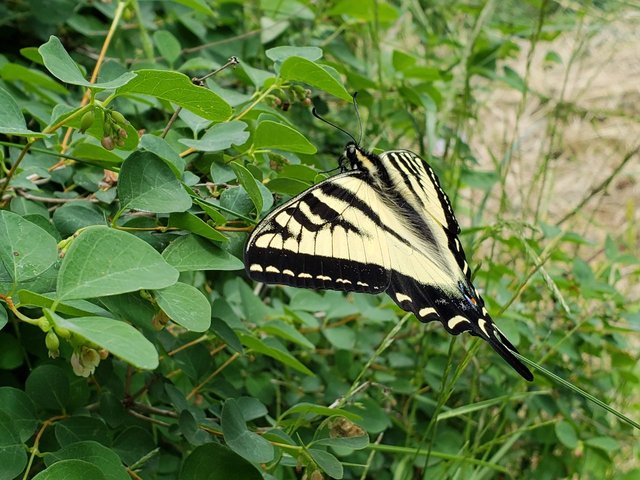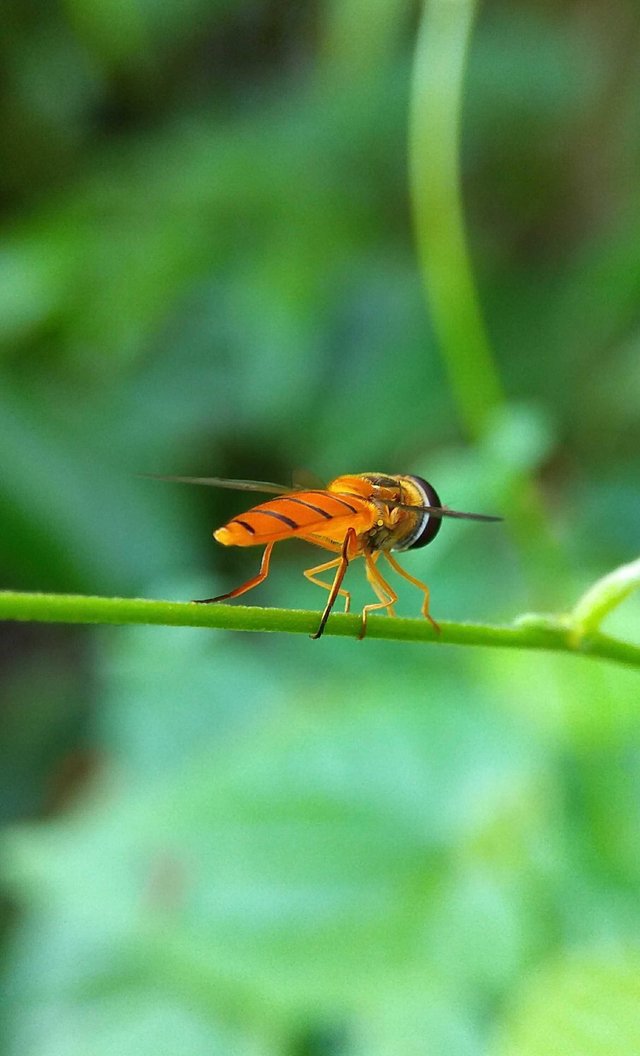Butterflies and Earth Changes
This is the third large butterfly like this that I have seen, (or at least noticed) this season. I’m not sure what kind it is but it is pretty big butterfly. I think that usually these kinds of butterflies like the bramble bushes, milkweeds and cattails but I'm not sure specifically what this one likes.
Most of that has been recently removed on the bike paths by the city workers. It has been largely mowed down now on all the walking paths that I usually walk on.
Bramble bushes do become what most consider a ‘noxious weed’ around here and form a thick hedge if left to their own. They are hard to control and most people remove this type of vegetation from their yards. I have blackberries in my backyard but I spend a lot of time keeping them trimmed so they don’t spread to the neighbors.
Some of these butterflies like tomato plants and other cultivated crops. I don’t know if that is the case for this type.
The first two butterflies like this that I saw this season may have been hit by my car – there was no way to slow down fast enough. I don’t think that they made it but I hope they did. They were flying along close to each other.
I really like the colors in the wings and tail of this butterfly. I like to think of things I can do that would be of help for it to survive.
As I recall there were many more butterflies and insects around when I was growing up. Sometimes you could not even see out of the car windows if you did not clean them each time you filled up with gas.
Earth Changes
So much is happening now that it is no wonder that there are less butterflies and insects around here to see. The earth is changing.
This summer could get very hot and disrupt the harvest. (It is not my personal garden harvest that I’m most concerned about, lol)
The oceans are producing less oxygen for a variety of reasons while the carbon dioxide level continues to rise. Fresh water is melting off Greenland glaciers and disrupting the North Atlantic ocean currents. The flow rate of this overturning ocean current has been reduced by a very large amount, (something like three times the rate of the water flowing in all the earths rivers?).
I’ve heard that strange things are happening to the jet stream winds because there is less difference in temperature between the equator and poles. This is changing the storm patterns and causes flooding in some areas and droughts in others.
There has been increases in volcanic activity and quakes. This could be in part from changes in the global average temperature. Water weighs a lot and when it melts from glaciers it redistributes the weight into other areas causing the sea level to rise and the plates the continents ride on to move around more (some land areas get less of a load on them from the melting of the glacier ice). Estimates of how much water has melted from Greenland and Antarctica are enormous. Increasing seismic activity could also be caused from really big hurricanes because they move large amount of ocean water around as they travel over the ocean.
The ozone layer appears to be thinning in patches now and letting in increasing amounts of UVB light which is hazardous to plant and animal life. I’ve head that increasing amounts of chlorofluorocarbons were detected being released into the atmosphere recently. These chemicals were banned years ago because of the danger to the ozone layer, see more info on: ozone hole forming chemicals. The increasing UVB light could be harming the oceans phytoplankton which produce large amounts of the oxygen that we need to breathe.
Deforestation, reduced ocean biomass, etc., etc. the list could go on and on.
I’m not sure what all these changes will do but it does give me an uneasy feeling. I’ve been trying to learn all I can about it but it is hard to get all the facts straight, please forgive me if any of this information in not fully accurate.
Thanks for reading! I always value your support and comments. The pictures were taken by me with my Galaxy S9+.



hi, brother @lightplasher how are you wishing you stay healthy, sorry i'm a bit late, i really like to see this butterfly, and also look its color so Beautiful, maybe you also know i like about binatnag like this, and i am very touched by the shape this butterfly is so beautiful its form, thank you relatives have shared the things I like about photography,
Hi, thank you! I was very happy to be able to get a photograph. I'm glad you liked the shape of the butterfly, I too think it is shaped nicely.
Same brother, Iya is indeed very good shape and color butterflies it but that I have never seen in my country brother, oh yea brother you can see photography dragonfly me
What a unique color of this butterfly, I really like the unique and I have not been able to capture a single butterfly as long as I have a hobby of photography. thank you for sharing the beautiful. I love it.
Thank you, it is not often that I see these types of butterflies. Carrying a camera with me all the time does help to get more photos - I'm really enjoying having a good phone camera.
You are welcome brother. Maybe I should learn a lot from you. always bring a camera wherever we go it is a very good idea.
Drastic changes are definitely taking place, I fear for the next generation. I hope we can salvage some of this.
It is tough to witness all the changes. Positive things are definitely happening as well, but it seems to be very slow to change and the outcome is very unpredictable imho.
At first glance I thought it was a scarce swallowtail, but you don't have those in the USA, and there are a few differences in the markings. Maybe a tiger swallowtail?
Anyway: butterflies are having similar problems in Europe. No good will come of this.
I'm thinking that it might be a Western Tiger Swallowtail but I'm far from an expert in identifying butterflies. It is fun learning more about them.
Something seems to be tough on butterflies and other things, I do hope it turns around soon.
butterfly is very beautiful, I really like the butterfly. what is the connection between butterflies with the depletion of the ozone layer ??
The depletion of the ozone layer increases the UV light hitting the earth and this light harms the animals and plants. Many things are indirectly related. Increasing UV light is probably part of the reason for a decrease in oxygen production from the ocean. Increasing UV coupled with high temperatures can lead to loss of butterfly habitat.
I think this butterfly is a very rare butterfly in my place, because I have never seen a butterfly like this .. ,, I really like this Butterfly .. I wish there was free time coming to my blog @ marcosteem to see my posts. I hope that happens
Thank you, I like this butterfly too and was very happy to get some photos. It looks like your a nature lover and have some nice macro photos on your blog.
thank you for looking at my blog kawan.saya very happy to be friends with you. I hope you can follow me and we can be a close friend. I have followed you friend. Because I like someone like your nature lover
Word editing
thank you for looking at my friend's blog. I am very happy to be friends with you. I hope you can follow me and we can be close friends. I have followed you friend. Because I like someone like your nature lover
hi brother @lightsplasher this is the post that last night i wrote in my phothography but now just ready for a bit busy in paddy field, if you are not busy now try saudar see my new phothography, i am glad you see this phothography thank you brother

Wow Beautiful Butterflies. That is excellent photography and nice work
Thanks @lightsplasher
Have a great day
Hi, thank you, have a great day too. :)
I recently took pictures of one of these butterflies myself. It was feeding on the nectar of the flowers on some kind of bush.These butterflies are not uncommon in the upper great lakes region where I live, but I don't see as many as I used to. I'm not sure what kind of plants their caterpillars feed on, hopefully not tomato plants. :-)
I think the warming of the oceans in the far northern and southern lattitudes has as much to do with the loss of plankton as anything else, but I do think that the increase in UV rays is affecting plant life in a not so good way.
I remember seeing some really big worms when I lived in the Midwest, that would munch on an entire tomato plant if you didn't remove them. I have not seen any of those so far in the Pacific Northwest. There are other things that make tomato growing hard around here though.
There is always a bit of a compromise when you love both tomatoes and the worms that change into butterflies.
UV rays are really tough on people too. My friend just had a skin cancer removed yesterday.
a butterfly is very beautiful, I really like see at the shape and colour of this beautiful butterfly. looks very good
Thank you, I was glad to be able to get some photographs of it. It is always fun to share stuff like this.